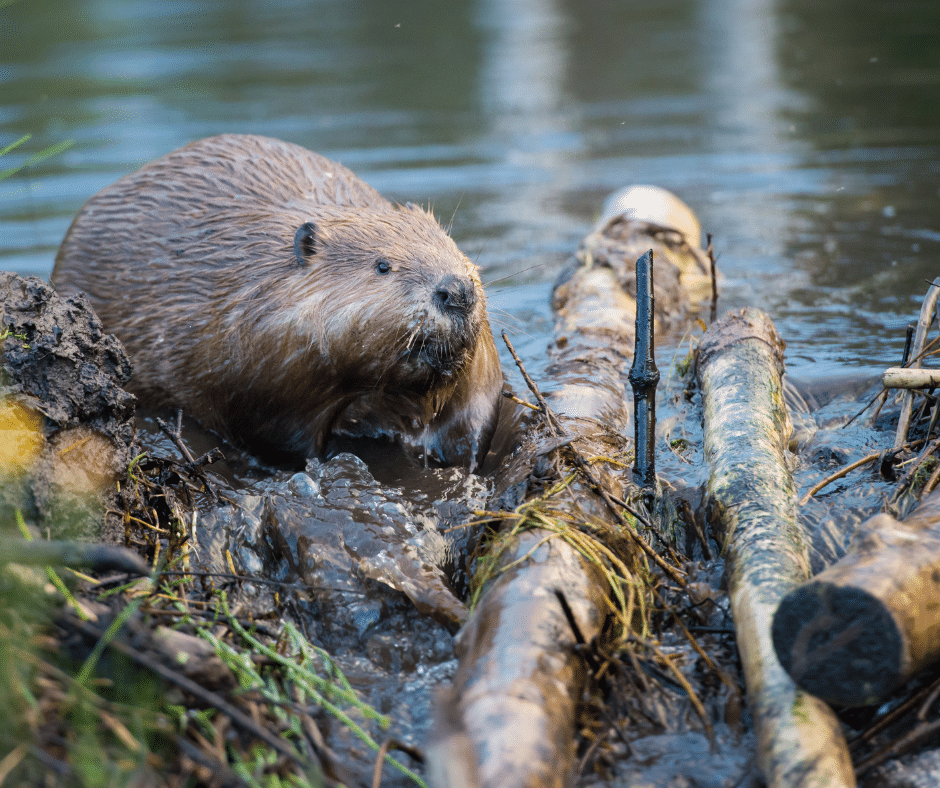An Introduction to the Beaver
Did you know the beaver lives all across the US? They sure do! And their dam-building abilities keep them safe from predators and provide them with calm waters in which to swim. However, these dams can cause a real issue for humans. That said, unregulated trapping almost led to their demise in the late 1800s. However, the demand for beaver pelts has gone down, and they are once again widely seen throughout the states.
Contact Covenant Wildlife Removal if you have a beaver problem in or near your home or business.
Learning More About the Beaver
Beaver Appearance
As the largest rodent in North America, the beaver is a semi-aquatic mammal. They have webbed hind feet, large incisor teeth, and a broad, flat tail covered with leathery scales and spars, coarse hairs.
Weight: up to 40 lbs
Length: 3 feet, including the tail.
Tail: up to 15 inches long and 6 inches wide.
Lifespan: 12 years in the wild

The Beaver’s Tail and General Behavior
The tail of a beaver is essential to its survival. You see, the tail stores fat and releases body heat which helps the beaver regulate body temperature.
Now, the tail has other uses as well.
On land- On land, the tail acts as a prop whenever the beaver is sitting or standing. And, it is a balancing tool for when the beaver is carrying heavy building materials in its teeth, paws, and front legs.
In water- In the water, the tail is like a flexible rudder. Also, when in danger, the beaver can notify other beavers of the impending danger with slaps on the water’s surface. It may even frighten predators away.
Beavers live in dens, like most rodents in the wild. And these dens can usually be reached by an underground water source. There they will be sure to have a place to eat, a dry nest, and fresh air.
Diet
Beavers live where there is food and water, along streams, rivers, marshes, lakes, and ditches. They prefer to eat the leaves, bark, and twigs of aspen, alder, birch, cottonwood, willow, and other deciduous trees. But they will eat other plants and coniferous trees as well.
Beaver Dams
Perhaps the most exciting part of getting to know the beaver is the dams they build. Dams are constructed and maintained with any readily available materials. These materials include but are not limited to wood, stones, mud, and plant parts. And the dams range in size from a small structure to those 10 feet high and over 165 feet wide.
They build these dams for several reasons, including the following:
- To flood an area for protection
- Access to dens and their food supply
- In cold areas, they help hold the water at the correct depth, so the source will not freeze all the way to the bottom.
- And, it is innate for them to hear water trickling and feel the need to build a dam.
Now, here is the problem associated with the beaver dam. You see, dams alter the flow of rivers and waterways. They can even cause floods in areas. This affects the chemical makeup of the site, the birds, amphibians, fish, and forestry. When there is any change in a natural area, there are consequences. And those consequences can be devastating to other species.
Reproduction and Families
Did you know a mated pair of beavers will stay together for many years? And as they reproduce each year, the babies, or kits, will live there with them for around two years. So, each den may contain 2 to 12 beavers.
Female beavers will produce a litter containing an average of 4 kits at some point between April and June.

Fun Facts About the Beaver
Want to know some of the fun facts about these funny rodents? We thought so.
- They can hold their breath underwater for up to an incredible 15 minutes.
- Beavers store branches underwater for consumption throughout the winter.
- They do not use their tails to pack mud into their dams, as often depicted.
- Beaver kits can swim 24 hours after birth.
- The world’s largest beaver dam is located on the southern edge of Wood Buffalo National Park in Alberta, Canada. And it is twice the length of the Hoover Dam, at 1,244 feet long.
- The beaver is featured on the back of the Oregon state flag.
Covenant Wildlife Removal Removes Nuisance Pests from Your Home and Property
What sets us apart from animal control is that we can manage the elimination of nearly any type of wildlife, including beavers, squirrels, bats, mice/rats, snakes, chipmunks, raccoons, muskrat, birds, alligators, and more.
Covenant Wildlife Removal is a top-rated local family-owned, full-service wildlife trapping, removal, and repair service. We can remove a nuisance pest or rodent infestation before it becomes an extensive problem for you and your family.
Do not wait; call us today for a free examination of the issue to offer you an immediate solution and quote.


